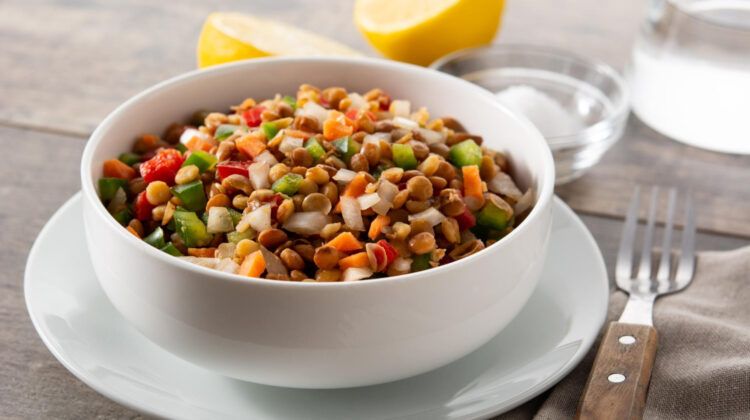Benefits of Black-Eyed Peas Salad

Black-eyed peas, commonly known as cowpeas, are a popular legume grown all over the world.
Despite their name, black-eyed peas are a type of bean, not a pea. They have a big black, brown, or red patch that resembles an eye and are often quite light in color.
Black-eyed peas have a rich, savory flavor and are commonly used in Indian and traditional Southern cooking. This article discusses the nutrition information, advantages, and applications of black-eyed peas.
Nutritional breakdown:
Black-eyed peas are extremely nutrient-dense, with a high fiber and protein content in each serving.
They are also high in a variety of micronutrients, including folate, copper, thiamine, and iron.
One cup (170 g) of cooked black-eyed peas provides the following nutrients:
- 194 calories
- 13 grams of protein
- 0.9 grams of fat
- Carbohydrates: 35 g
- 11 grams of fiber
- Folate: 88% of the daily value
- 50% of the DV (Daily Value) is copper
- Thiamine: 28% of the daily value
- Iron: 23% of the daily value
- Phosphorus: 21% of the daily value
- Magnesium: 21% of the daily value
- Zinc: 20% of the daily value
- Potassium: 10% of the daily value
- 10% of the DV for vitamin B6
- Selenium: 8% of the daily value
- Riboflavin: 7% of the daily value
In addition to the nutrients stated above, black-eyed peas are high in polyphenols, which are chemicals in the body that serve as antioxidants to prevent cell damage and disease.
Black-eyed peas have a high protein and fiber content, as well as minerals including folate, copper, and thiamine.
Advantages
Black-eyed peas have been linked to a variety of profound health advantages.
- Help with weight loss:
Including black-eyed peas in your diet is an excellent strategy to increase weight loss due to their high protein and soluble fiber levels.
Protein has been proven to lower ghrelin levels, a hormone that stimulates feelings of hunger. Soluble fiber, on the other hand, is a type of fiber that has a gel-like consistency and passes slowly through your digestive tract to help you feel full between meals.
One research of 1,475 adults found that those who ate beans regularly had a 23% reduced risk of increasing belly fat and a 22% lower risk of obesity when compared to non-consumers. Another 21-study evaluation showed that incorporating pulses in your diet, such as black-eyed peas, could be an effective weight loss strategy and may help reduce body fat percentage.
- Improve intestinal health:
Black-eyed peas are high in soluble fiber, which is an important component for digestive health. Research shows that increasing your soluble fiber intake can help promote regularity and increase stool frequency in people who suffer from constipation.
Fiber may also help prevent digestive disorders such as acid reflux, hemorrhoids, and stomach ulcers, according to another research. Soluble fiber contained in black-eyed peas and other plants can also work as a prebiotic, encouraging the growth of good bacteria in your stomach and promoting a healthy microbiome.
These good bacteria not only help with digestion, but they have also been demonstrated to reduce inflammation, improve immunological function, and lower cholesterol levels.
- Improve heart health:
Black-eyed peas are a wonderful method to help keep your heart healthy and strong as part of a balanced diet, since they may help minimize numerous risk factors for heart disease.
Regular consumption of legumes was linked to decreased levels of total and LDL (Low-Density Lipoprotein) (bad) cholesterol in one evaluation of ten trials, both of which can contribute to heart disease. Another study in 42 women found that adopting a low-calorie diet rich in 1 cup of beans per day for 6 weeks significantly lowered waist circumference, lipid, and blood pressure levels when compared to a control group.
Eating beans regularly has also been linked to reduced inflammation markers, which may help reduce your risk of heart disease.
- Health Concerns During Pregnancy:
One half-cup portion of black-eyed peas includes 44 percent of the daily recommended intake of folate, a B vitamin that helps to reduce the risk of brain and spinal cord abnormalities in newborn babies.
- Weight control:
Consuming black-eyed peas can help you maintain a healthy weight. Black-eyed peas are high in both soluble and insoluble fiber, which aids in weight management. Black-eyed peas’ protein and slow-digesting, high-quality carbs also help you feel full.
- Increased energy levels:
One half-cup portion of black-eyed peas supplies 40% of the recommended daily manganese requirement for males and 52% for women. Manganese is an antioxidant that protects the cell structures that produce energy in your body. Black-eyed pea protein also aids in energy production.
- Better eye health:
One half-cup portion of black-eyed peas has 13% of your daily vitamin A requirement. Vitamin A benefits eye health by protecting your corneas, assisting your body in producing lubricant for your eyes, and assisting in retina function.
- Diabetes risk is reduced:
Black-eyed peas include soluble fiber, which helps the body manage blood sugar levels and minimizes the danger of blood sugar spikes. Because of this reduced risk, black-eyed peas are a good choice for diabetics.
- Bones that are stronger:
One half-cup portion of black-eyed peas contains 8% of the daily required calcium consumption, a vitamin essential for bone strength.
- Digestion ease:
The soluble and insoluble fiber in black-eyed peas improves digestion by assisting your body in producing a thicker, easier-to-pass stool. Fiber also aids in the solidification of loose, watery stools and the maintenance of gut health.
What about its side effects?
One disadvantage of eating beans daily is that it can induce an increase in intestinal gas. There are a few things people can do if this happens to them.
Initially, high-fiber foods should be introduced gradually into the diet, especially if the person is not used to eating them. Another strategy is to soak dried beans before boiling them, which makes them simpler to digest.
Discover 20 various methods for releasing trapped gas.
How to Cook Black-Eyed Peas?
Cooking canned black-eyed peas straight from the can is an option. If a person is using dry black-eyed peas, they should soak them first. This cuts down on their overall cooking time.
Remove any undesired items, such as rocks or stones, before soaking dried black-eyed peas. Then use one of the following two methods:
- In a big pot, cover the dried beans with about 3-4 inches of cold water. Soak the beans in water overnight. Simply drain, rinse, and cook the next day. People can try taking digestive enzymes before or during high-fiber meals. There are also numerous over-the-counter medications available for bloating, indigestion, and gas. Before beginning any new supplements, such as digestive enzymes, consult with your doctor because they may not be appropriate for everyone.
Put the beans in a pot, cover them with water, and bring the water to a boil for 2-3 minutes before removing the pot from the heat source. Let the beans soak for 1 hour before draining and washing the peas.
It is time to cook the peas after any soaking method. Put the peas in a big saucepan with just enough fresh water to cover them. Bring the mixture to a boil, then reduce to low heat and cook for 40 minutes, or until the peas are soft.
